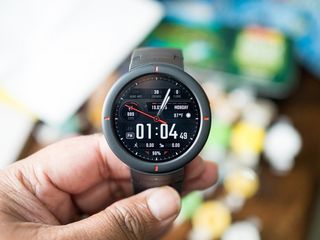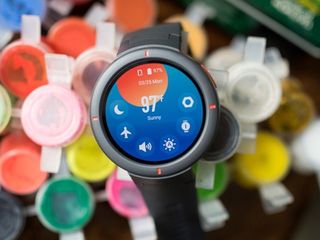Amazfit has carved out a name for itself over the last 18 months as a purveyor of affordable fitness bands and smartwatches. The Bip showed that the brand could do a great job with a sub-$100 smartwatch, whereas the fitness-focused Stratos is positioned against the likes of Garmin and Polar.
The Verge is also aimed at the fitness segment, but it has more mainstream features that make it a great everyday smartwatch. Coming in at just $160, it hits the sweet spot for value while offering a plethora of features that make it stand out in this category.
Pros:
- Excellent value
- Lightweight design
- Five-day battery life
- Vibrant AMOLED display
- Built-in GPS
Cons:
- Charging cradle is bulky
- Inconsistent sleep tracking

Amazfit is Huami's consumer-facing brand. Although the name may be unfamiliar to many, Huami is one of the world's largest wearable manufacturers, with the company working with Xiaomi to make the Mi Band lineup of fitness bands. Huami has lofty ambitions in this space with the Amazfit brand — it rolled out an AI-enabled wearable chip with a cardiac biometrics engine and ECG features last year, and we'll see the platform powering Amazfit products later in the year.
Amazfit dubs the Verge as a smartwatch for the "fashion-conscious fitness enthusiast," and that's evident from the design. There's a large 1.3-inch AMOLED display that's encased in a polycarbonate chassis, with a single home button to the right. The smartwatch comes with a removable silicone strap, but because of its unique design, you won't be able to switch out the band with ones you already own — you'll need to buy bands customized for the Verge.
The Verge feels comfortable to wear all day and offers a ton of fitness tracking features.
The smartwatch is available in three color options — Twilight Blue, Shadow Grey, and Moonlight White — and there's a wide array of features inside: IP68 dust and water resistance, Wi-Fi b/g/n, Bluetooth 4.0, GPS + GLONASS, 24/7 heart rate monitoring, as well as an accelerometer, ambient light sensor, and barometer.
Although the chassis is plastic, the soft touch material and the flexible silicone band make it comfortable to wear the Verge for extended periods. The smartwatch is also light at 46g, and the 43mm diameter doesn't make it too big for smaller wrists. The Verge features a 1.3-inch AMOLED display with a resolution of 360 x 360 pixels under a layer of Gorilla Glass 3. Even under harsh sunlight, I had no issues seeing the Verge's screen clearly.
You can choose from 10 watch faces, and the colors take full advantage of that vibrant AMOLED panel. As it's an AMOLED screen, you get a low-power always-on display that shows the time when the screen is off, though the feature is disabled out of the box. You'll have to go into the settings to enable it.





You get 4GB of internal storage, of which 2GB is available for storing music and other data. The offline storage combined with built-in GPS means you can leave your phone behind when running outdoors, as you can just pair your wireless earbuds to the Verge directly. The 2GB storage limits the amount of songs you can listen to, but it's a decent option nonetheless. There's also an optical heart rate sensor continually monitoring your heart rate over the course of the day, and it can detect irregular patterns.
The Verge is powered by a 1.2GHz dual-core chipset with 512MB of RAM. There's also a mic that lets you take calls directly from your wrist, provided you pair the watch with your phone. The feature works pretty well, and I had no issues with the few calls I took on the Verge. The built-in speaker is pretty loud, but it's more suited for use in a quieter setting. The speaker also lets you play music directly from the watch.
The Verge has a 390mAh battery that's touted for five days in normal use, or just under a day with GPS enabled throughout. You'll even be able to eke out a 10-day battery life by limiting a few features. In the two months I used the smartwatch, I routinely saw over five days of battery life from a full charge, and in general it's great to be able to use a smartwatch that you don't have to charge every night. The only issue I have on this front is that the charging cradle is too bulky, and it's often a hassle to remove the watch from the charging cradle.

Amazfit has its own software interface, and that's what powers the Verge. You get 12 widgets out of the box, and the single button on the right is used for waking the screen or exiting a widget to go back to the watch face. You'll be able to view all notifications with a swipe up gesture, and a swipe to the right dismisses them. You can access settings and quick toggles with a swipe down motion.
Amazfit's custom software interface is slick and has lots of customizability.
You'll be able to choose what apps send notifications by pairing the watch to your phone. Pairing itself is fairly straightforward: install the Amazfit Watch app from the Play Store and point it at the QR code shown on the watch. Once your phone is paired, you'll be able to select a watch face and customize the experience.
Coming to the fitness side of things, the Verge is able to automatically track 11 sports and sports-like activities, including running, walking, cycling, climbing, tennis, elliptical training, skiing, soccer, and more. The bevy of onboard sensors along with built-in GPS give you accurate and detailed statistics on your workouts, and in this regard the Verge does just as well as Garmin's range of products.
The Verge doesn't have quite as many features as the Stratos, which has an always-on display, is water resistant up to 5ATM, and measures maximum oxygen consumption. With the Stratos now on sale for $180, that makes it a more compelling option for those looking for a more serious fitness-focused smartwatch. That said, the Stratos is larger and heavier, and you can't take phone calls on your wrist as it doesn't have a built-in mic. For what it costs, the Verge delivers an outstanding experience.
4.5 out of 5
The Amazfit Verge does a great job bringing features that were thus far relegated to products costing over $300. The AMOLED panel is bright and offers vibrant colors, the custom interface isn't laggy, you get the ability to store music directly on the watch, and the built-in GPS and heart rate sensors are accurate. The fact that you get all of these features for just $160 is staggering, and makes the Verge a standout fitness-focused smartwatch.

Harish Jonnalagadda is a Senior Editor overseeing Asia at Android Central. He leads the site's coverage of Chinese phone brands, contributing to reviews, features, and buying guides. He also writes about storage servers, audio products, and the semiconductor industry. Contact him on Twitter at @chunkynerd.
